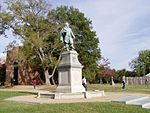Portal:Virginia
The Virginia Portal  Virginia, officially the Commonwealth of Virginia, is a state in the Southeastern and Mid-Atlantic regions of the United States between the Atlantic Coast and the Appalachian Mountains. The state's capital is Richmond and its most populous city is Virginia Beach, though its most populous subdivision is Fairfax County, part of Northern Virginia, where slightly over a third of Virginia's population of 8.72 million live. The Blue Ridge Mountains cross the western and southwestern parts of the state. The state's central region lies predominantly in the Piedmont. Eastern Virginia is part of the Atlantic Plain, and the Middle Peninsula forms the mouth of the Chesapeake Bay. The fertile Shenandoah Valley fosters the state's most productive agricultural counties, while the economy in Northern Virginia is driven by technology companies and U.S. federal government agencies, including the U.S. Department of Defense and Central Intelligence Agency. Hampton Roads is also the site of the region's main seaport and Naval Station Norfolk, the world's largest naval base. (Full article...) Selected articleThe Pittston Coal strike was a United States labor union action led by the United Mine Workers Union (UMWA) against the Pittston Coal Company, nationally headquartered in Pittston, Pennsylvania. The strike, which lasted from April 5, 1989 to February 20, 1990, resulted from Pittston's termination of health care benefits for approximately 1,500 retirees, widows, and disabled miners. The strikers also cited the refusal of the company to contribute to the benefit trust established in 1950 for miners who retired before 1974 and the refusal of the company to bargain in good faith as grounds for their action. The company cited declining coal prices, decreasing demand, and recession as its reason for limiting health care benefits. The strike affected production in mines mostly in Virginia, but a few in West Virginia and Kentucky as well. Mine workers and their families engaged in acts of civil disobedience, work stoppage, protests, and rallies. At its peak in June 1989, the strike involved approximately 2,000 miners daily staying at Camp Solidarity with thousands more sending donations and holding wildcat walkouts that involved around 40,000 people. The participation of women in the labor action through the ad hoc formation of the Daughters of Mother Jones—reminiscent of the early days of union organization—proved an essential element of the successful strike. Selected biography
Francis Nicholson (12 November 1655 – March 16, 1728 [O.S. March 5, 1727]) was a British military officer and colonial administrator. His military service included time in Africa and Europe, after which he was sent as leader of the troops supporting Sir Edmund Andros in the Dominion of New England. There he distinguished himself, and was appointed lieutenant governor of the dominion in 1688. After news of the Glorious Revolution reached the colonies in 1689, Andros was overthrown in the Boston Revolt. Nicholson himself was soon caught up in unrest in New York, and fled to England.
He next served as lieutenant governor or governor of Virginia and Maryland. He supported the founding of the College of William and Mary, and quarreled with Andros after Andros was selected over him as governor of Virginia. In 1709 he became involved in colonial military actions during Queen Anne's War, leading an aborted expedition against Canada. He then led the expedition that successfully captured Port Royal, Acadia on 2 October 1710. Afterward he served as governor of Nova Scotia and Placentia, and was the first royal governor of South Carolina following a rebellion against its proprietors. He rose to the rank of Lieutenant-General, and died a bachelor in London in 1728. He supported public education in the colonies, and was a member of both the Society for the Propagation of the Gospel in Foreign Parts and the Royal Society. He also influenced American architecture, being responsible for the layout and design of Annapolis, Maryland and Williamsburg, Virginia. He was one of the earliest advocates of colonial union, principally for reasons of defense against common enemies. This month in Virginia history
Random Virginia articleA random generator will select an article about… 
(note: generator may be slow) Things you can do
Tasks
Selected image Downtown Roanoke at night, as viewed from the Mill Mountain overlook Did you know -
Fact sheet
State symbols:
Government
Related portalsVirginia topicsSubcategoriesSelect [+] to view subcategories
Associated WikimediaThe following Wikimedia Foundation sister projects provide more on this subject:
Discover Wikipedia using portals |


























